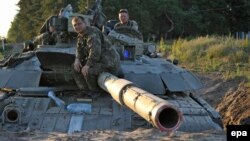As the crisis in eastern Ukraine shows no sign of deescalating in the wake of a cease-fire agreement reached in September 2014, pressure is growing for Western countries to provide lethal military assistance to Ukraine and to ramp up their provision of nonlethal aid.
On February 2, the Atlantic Council, together with the Brookings Institution, issued a new report urging the United States to provide $3 billion in lethal and nonlethal military aid to Ukraine.
But it is a controversial idea that could result in a significant intensification of the violence in the region and runs the risk of a serious direct confrontation with President Vladimir Putin's Russia.
Why are such proposals gaining traction?
The Ukrainian government has suffered significant military setbacks in recent weeks as it has become increasingly clear that the cease-fire is not working. NATO estimates that Russia-backed separatists have taken about 500 square kilometers of territory in the past 16 weeks, including the heavily contested Donetsk airport.
Separatist leaders on February 2 announced plans to recruit 100,000 additional fighters for the war against Kyiv.
Western governments have also accused Russia of sending significant quantities of heavy weapons to the insurgents, including armored personnel carriers, heavy battle tanks, artillery, and heavy rocket launchers. NATO experts estimate that about 1,000 Russian combat troops and advisers are operating inside Ukraine, although Kyiv argues that number is much higher.
Moscow maintains it has no forces inside Ukraine and is not a party to what it calls the "civil war" in that country. Moscow has accused Kyiv of seeking to resolve the crisis exclusively by military means.
Who supports giving weapons to Ukraine?
The Atlantic Council report was authored by eight former U.S. officials, including a former top NATO military commander, a former U.S. ambassador to NATO, two former U.S. ambassadors to Ukraine, and a former deputy secretary of state.
These experts join several influential U.S. senators, including Arizona Republican John McCain and New Jersey Democrat Robert Menendez. According to The New York Times on February 2, Secretary of State John Kerry, Defense Secretary Chuck Hagel, Chairman of the Joint Chiefs of Staff Martin Dempsey, and NATO Commander Philip Breedlove all are now open to the possibility of such aid to Ukraine.
Obama's national security adviser, Susan Rice, is also said to be softening her long-standing resistance to stepped-up military aid to Kyiv.
In addition, British historian Timothy Garton Ash on February 1 urged the West to give Ukraine "modern defensive weapons to counter Russia's modern offensive ones."
The U.S. Congress has already passed the Ukraine Freedom Support Act, which allocates $350 million for the administration to provide military aid to Ukraine. President Obama has considerable leeway to decide what equipment to provide and when. The Atlantic Council proposal urges spending about eight times as much.
What sort of aid is being considered?
Concerning enhanced nonlethal aid, the Atlantic Council report urges the West to provide advanced radar systems that can help neutralize the separatists' multiple-launch rocket systems. It also calls for reconnaissance drones, as well as electronic countermeasures to combat drones under separatist or Russian control.
It calls for secure communications equipment that cannot be intercepted by the Russian military, more medical equipment, and armored Humvees.
As for lethal aid, the report calls for light antiarmor missiles for countering separatists' tanks and armored personnel carriers. It urges NATO members that have Soviet-style antiaircraft technology to share it with Ukraine while U.S. military experts devise a way to rapidly modernize Ukraine's air defenses. It calls on Washington to urge NATO members also to provide lethal military aid.
It stresses that the West must "steer clear of equipment that is of such technological sophistication that it would require U.S. or NATO personnel to operate or maintain" and cautions against "a direct U.S. or NATO presence on the ground."
What are the possible risks of such a policy?
Many argue that providing more military aid to Ukraine would force Moscow to counter by increasing its own support for the separatists. Such an escalation would certainly produce more violence in a war that has already seen thousands killed, hundreds of thousands displaced, and billions of dollars' worth of damage inflicted.
Some analysts say the West is unlikely to ever give Ukraine the level of assistance that would be needed to defeat the Russia-backed insurgency.
And stepping up lethal assistance would also provide fodder to Russian claims that the conflict in Ukraine is really a Western bid to contain or weaken Russia.















